|
- Catalog (in stock)
- Back-Catalog
- Mail Order
- Online Order
- Sounds
- Instruments
- Projects
- History Face
- ten years 87-97
- Review Face
- our friends
- Albis Face
- Albis - Photos
- Albis Work
- Links
- Home
- Contact
- Profil YouTube
- Overton Network
P & C December 1998
- Face Music / Albi
- last update 03-2016
|
Quartet Nit
Namulema Kigula Sylvia - voice and dance
Ritah Kobusingye - voice and dance
Israel Kalungi - voice, traditional instruments and dance
Jjemba Eric Lutaaya - voice, traditional instruments and dance
With members from the Naggalabi Indigenous Theatre (NIT), a community of artists with a centre in Naggalabi for local, traditional and contemporary arts and crafts. The institution was founded by Sylvia Namulema Kigula and Eric Jjemba Lutaaya and is located in Nsangi su county Wakiso district, Uganda.
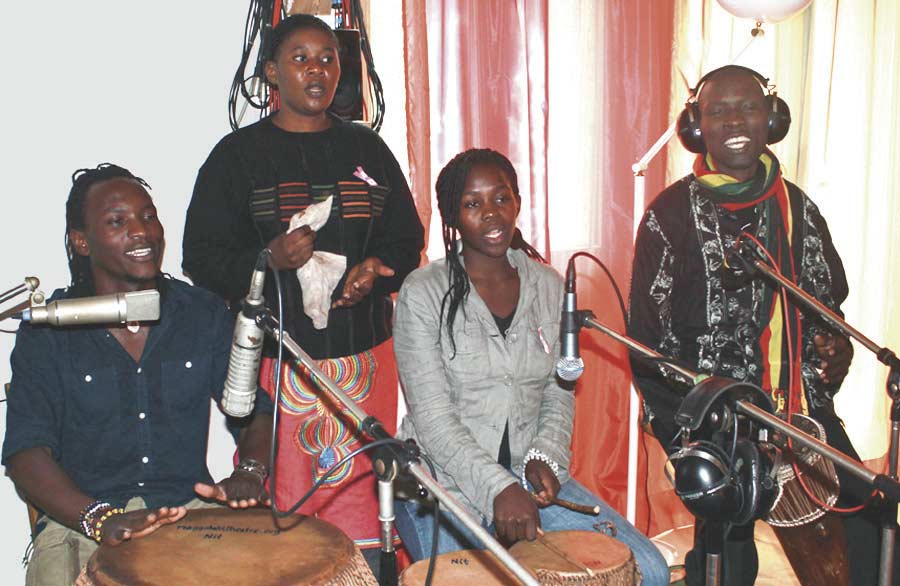
Israel, Sylvia, Ritah, Eric
Ensemble Nit
With members from the Naggalabi Indigenous Theatre (NIT), a community of artists with a centre in Naggalabi for local, traditional and contemporary arts and crafts. The institution was founded by Sylvia Namulema Kigula and Eric Jjemba Lutaaya and is located in Nsangi su county Wakiso district, Uganda.
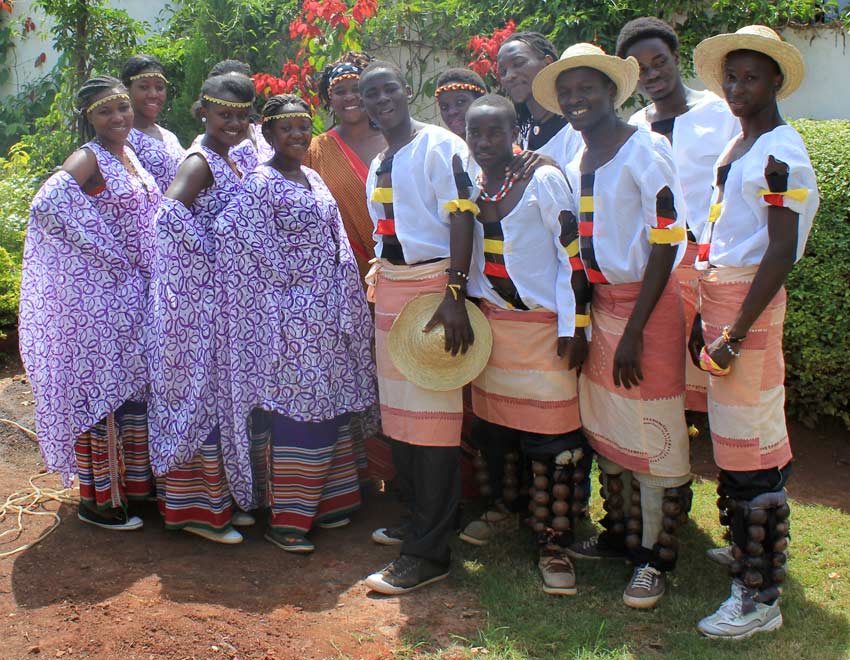 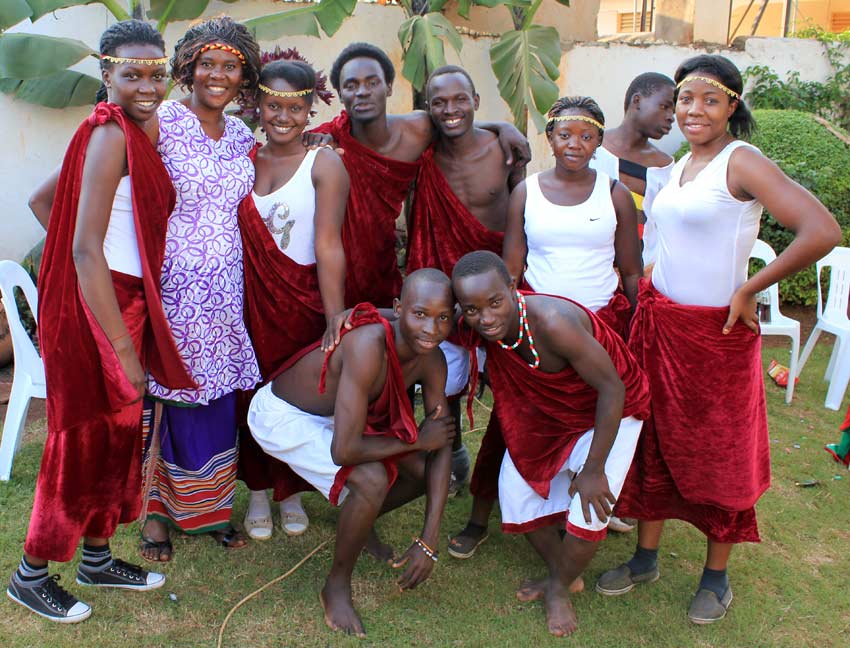
Africa is inhabited by different ethnic groups, each with a musical tradition of its own. This is a rich traditional music heritage that has been orally transmitted from generation to generation for centuries. Despite external influences, the majority of these ethnic groups continue to value and practice their respective traditional musical styles, which in turn have to establish strong musical and cultural identities and continue to do so.
Ugandan music is generally rhythmic, and the complexity of these rhythms varies due to the difference between the ethnic groups. These differences are also reflected in the varied instrumentation. Some musical genres are played on simple instruments while others, especially the dance music, are played in ensembles of complex instrumental formation. African music is usually pentatonic, but a few tribes also use a hexatonic scale. Most of the Ugandan vocal music is accompanied by traditional instruments. The literature embedded in vocal music is purposely meant to transform the social communities, i.e. in their structural adjustment.
Although Uganda is inhabited by a large variety of ethnic groups, a broad linguistic division is usually made between the Bantu-speaking majority, who lives in the central, southern and western parts of the country and the non-Bantu speakers, who occupy the eastern, northern and north-western portions of the country (these may be sub-divided into Nilotic and Central Sudanic peoples). The first category includes the large and historically highly centralized kingdom of Buganda, the smaller western Ugandan kingdoms of Bunyoro, Nkore and Batooro, and the Busoga states to the east of Buganda. The peoples in the second category (they constitute less than one-tenth of the population) include the Iteso, Langi, Acholi, Alur, Karimojong, Kakwa, Jopadhola, Kumam, Sebei (Nilotic language groups) and the Metu, Madi, Lugbara and Okebu (Central Sudanic group) in the north and a number of other smaller societies in the eastern part of the country.
Folktales
Folktales define community; reflect the history, traditional values and accumulated wisdom. Every culture has its own collection of ancient and traditional stories that have been orally transmitted from generation to generation.
On this album, we present two tales from the Buganda region where Baganda women told these stories to the children in the evening after work and before they had to go to bed around a fire. In some of the stories, general animals, birds and plants have human characteristics (souls), by means of which they talk and develop relationships with humans. They have a supernatural element which allows them to perform tasks only in folktales.
Stories have always been very significant to the tradition and the culture of Buganda. The young generation has been taught about the past of their kingdom, they have learnt about their ancestors, cultural taboos, history, values of life, etc.
Traditionally, the stories or legends were a main source of education in the African life style, that involved participation, which was oral and it was the way to teach the young ones to use and to know almost everything about their culture, people and historical background.
Songs and Dances of Bantu Women
The music of women in Bantu tribes is quite often part of the fabric of expression, which tells us who they are, not individually, but as a group - not in challenge to their culture, but in harmony with and support of the dominant and dynamic patterns of their culture. The songs and dances can be understood fully only by a tribe member, but we can benefit from an approach that looks at the textual content, the style (which includes their approach to composing), and the function of the songs and dances.
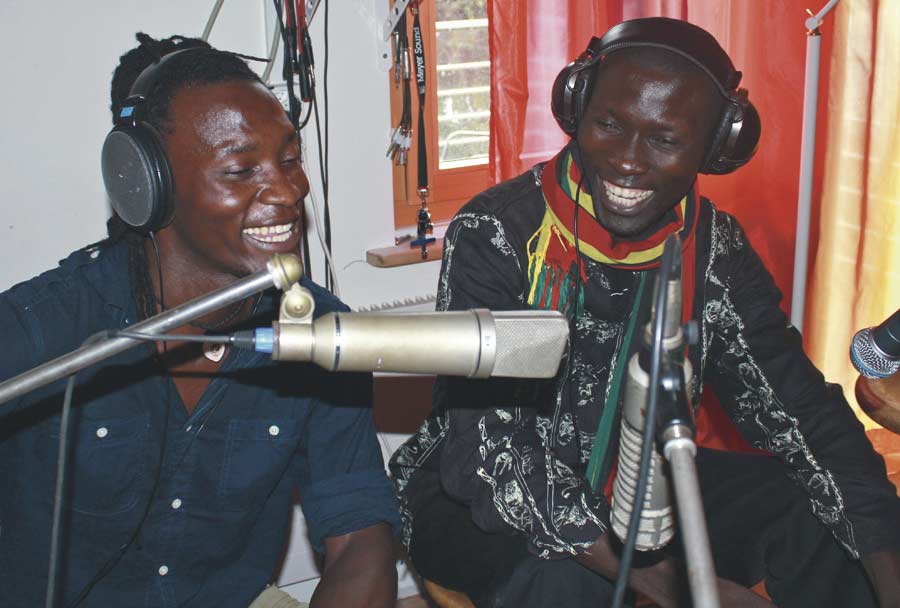
Israel & Eric
|
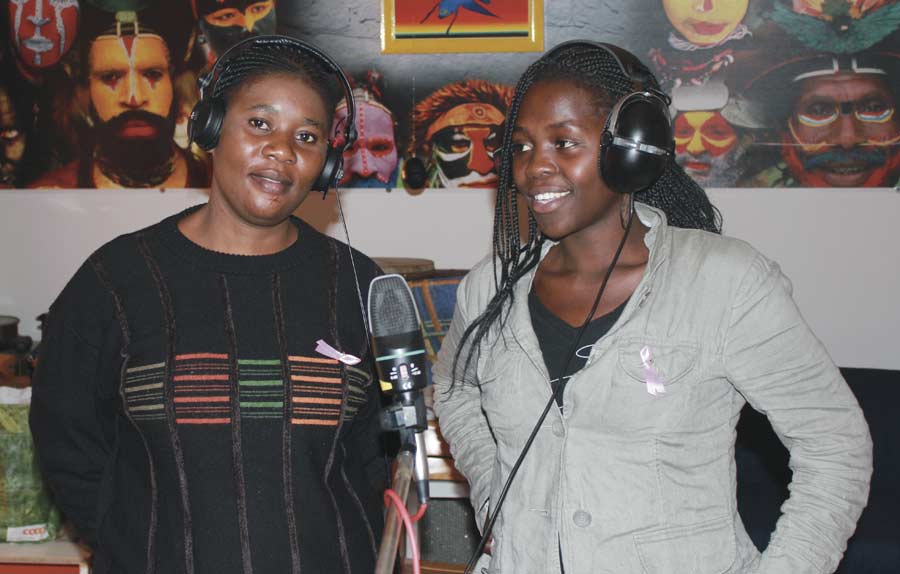
Sylvia & Ritah
|
|
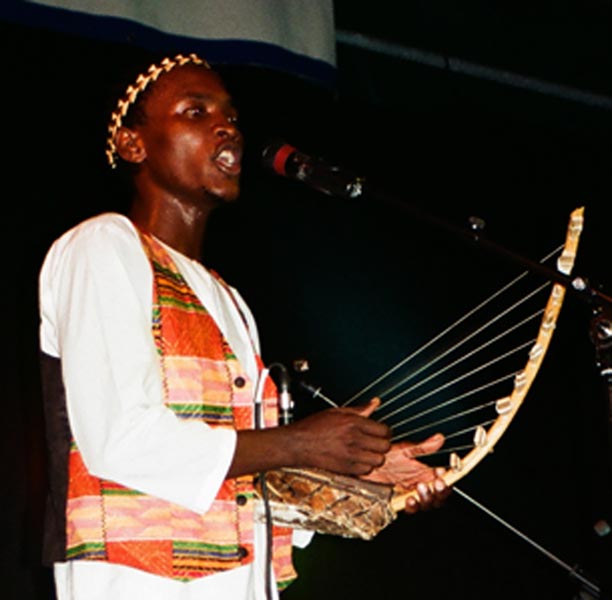
Israel
|
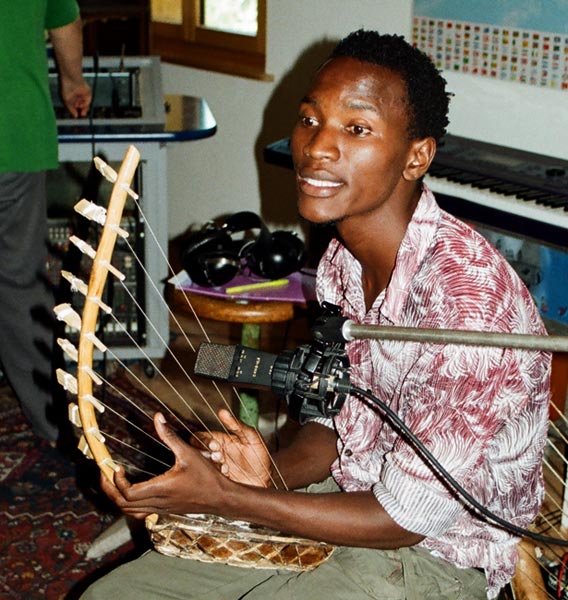
Israel
|
- see map sketch of Uganda
- see map sketch of Uganda regions
Stageplan:
- Quartet Nit (quartet)
Latest CD:
- FM 50041 - Traditional music from Uganda - Vol. I
- FM 50047 - Traditional music of the Bantu women and folktales of the Baganda women from Uganda - Vol. I
- FM 50054 - Traditional music from Uganda - Vol. II
- FM 50055 - Traditional music of the Bantu women from Uganda - Vol. II
- FM 50056 - Traditional music from Uganda - Vol. III - Wedding and Gathering Songs
- FM 50057 - Traditional music of the Bantu from Uganda - Twins rituals
- FM 50058 - Traditional music of the Bantu from Uganda - Vol. III - Lullabies and Dirge songs
- FM 50100 - Special edition - three albums - Traditional Dances from Uganda - Vol. IV - Vi
- FM 50062 - Traditional music from Uganda - Vol. IV - Harvest Celebration and Social Gathering Songs
- FM 50063 - Traditional music from Uganda - Vol. V - Courtship and Wedding Dances
- FM 50064 - Traditional music from Uganda - Vol. VI - War and Ritual Dances
Review:
- published by Ethnotempos -2007
Instruments
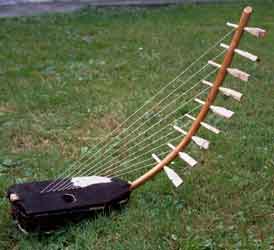 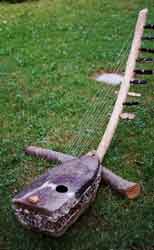
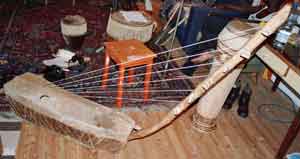
adungu bass
|
- Adungu, Adeudeu - bow harp - arched harp - string instument
The adungu is a nine-string arched (bow) harp of the Alur people of northwestern Uganda. It is very similar to the tumi harp of the neighbouring Kebu people, and it is also used by the Lugbara and Ondrosi tribes in this northwestern region around the Nile. The harp is used to accompany epic and lyrical songs, and it is also used as a solo instrument or within ensembles. Players of arched harps have had a high social status and are included in royal retinues. Nowadays they also play in churches.
The adungu consists of an arched neck, a wooden resonator (sound box) in which the neck is fixed, and a series of parallel strings of unequal lengths that are plucked. The strings are fixed at one end to the resonator and run at an oblique angle to the neck, where they are attached and tuned with pegs.
The first, second, and third strings are tuned in octaves with the sixth, seventh, and eighth respectively. In traditional music the instrument is tuned in a pentatonic (five-note) scale, but it can also be tuned in modern style to a diatonic scale.
|
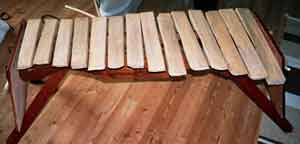 |
- Akadinda - Embaire - Entaara - Amadinda
xylophone - percussion instrument
The wooden keys of the various xylophones of the region can be resonated in various ways to amplify the tones. Resonators may take the form of small hollow objects beneath each key, a common sound box for all keys, or even a pit dug into the ground. In this last form, the keys lie parallel to one another over and across the pit, which is about 70 centimeters deep and almost two meters wide. The musician strikes the left-hand keys (the bass) with a mallet of fairly soft wood and the right-hand keys with a heavy crooked mallet made of extremely hard wood. The keys of a smaller version of this xylophone are set above a shallower pit. This smaller xylophone provides melodic and rhythmic ostinatos as a cue for the larger main xylophone, which plays different themes designed to persuade deities to dance at the ceremonies for the vodun (voodoo). A pair of rattles and an iron bell always complete a performance on this double xylophone, and the performance is often accompanied by song.
|
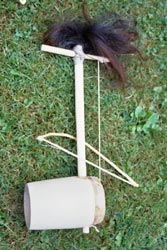
|
- Endingidi - Adigirgi - tube fiddle - one-string-fiddle - string instrument
This instrument is popular in the Buganda, Busoga, Ankole, Kigezi, western Nile, and Acholi regions. It consists of a single string, which is attached to a flexible stick and will sometimes have a resonator. Unlike other single-string instruments, it is played with a bow.
|
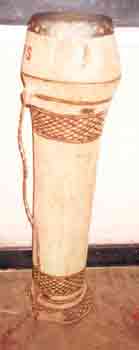 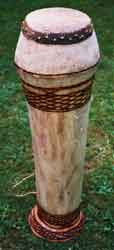
|
- Engalabi - long drum - percussion instrument
This traditional drum has a head made of reptile skin nailed to a wooden sound body. The engalabi from the Buganda region has an important roles in ceremonies and in theater. It is called "Okwabya olumbe". This is the installation of a successor to the deceased, thus the saying in Luganda (in Buganda a Bantu dialect) "Tugenda mungalabi", meaning we are going to the engalabi, that is, long drum. Rule in playing the drum is the use of bare hands.
|
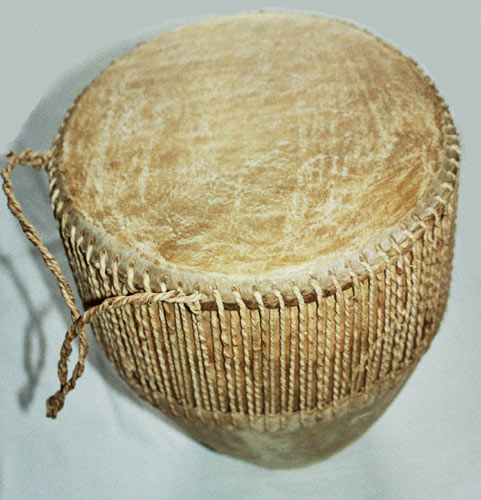
|
- Engoma - Empuunyi - Uganda drum - percussion instrument
Embuutu; big drum, Empuunyi; bass drum.
While larger versions of this drum are traditionally hand-carved from old-growth hardwood trees, now these drums are made with pinewood slats tied together like barrels. Smaller drums are laminated and turned on a lathe and may be provided with a rope carrying the handle. All these drums have heads made from hide held by hardwood pegs hammered into the side of the drum.
|
PageTop

|
